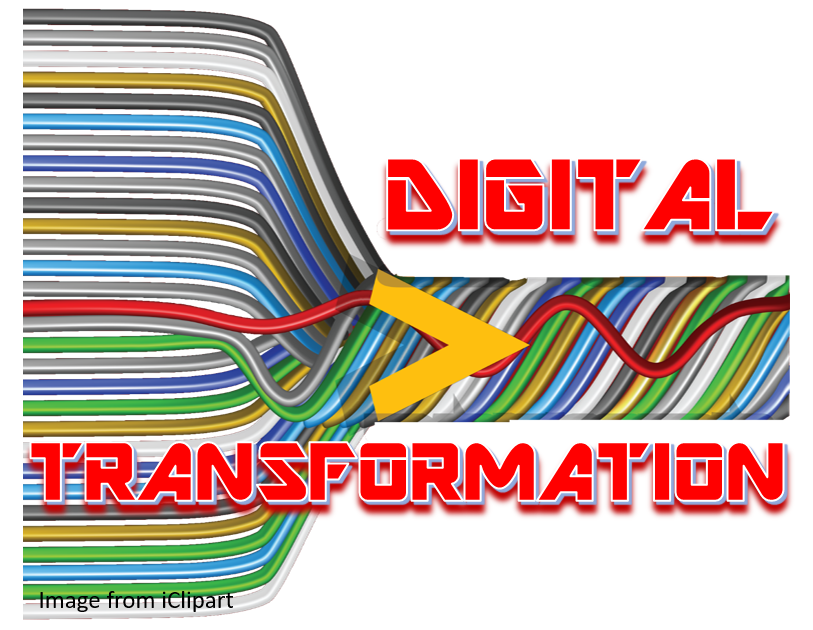How would you describe the age in which we live? What are its primary characteristics? You might point to the hectic pace of change; but, a well-known aphorism acknowledges “the world is constantly changing.” Other human eras have been designated by their primary technology: the Stone Age; the Bronze Age; the Iron Age; the Age of Sail; the Steam Age; etc. Applying that format, what characterizes the current age is digital technology. Although other eras have used data extensively to advance humankind, no other age has confronted the challenge of digital data. As a result, Google executive Jim Haar asserts, “Making your company a digital business is the only thing that really matters right now.”[1] Most experts agree companies built on Industrial Age principles need to transform into Digital Enterprises. But, as Haar notes, “Digital transformation is kind of a nebulous topic.” That’s because what it means to be a digital enterprise is different in every economic sector. The only thing most digital enterprises have in common is the fact they must deal with oceans of digital data. Future success will be determined by how well they meet the challenge.
Benefits and tools of digital transformation
Most of the benefits associated with digital transformation are provided by technologies aimed at dealing with massive amounts of data. Implementing those technologies (e.g., cloud services, cognitive computing, and Internet of Things) is therefore essential. What are the resulting benefits? Haar asserts, “Benefit number one is agility. … Benefit number two is cost.” How important is digital transformation? Analysts from Adext assert, “One of the greatest risks of this new era is the technological lag that threatens business competitiveness.”[2] In other words, digital transformation laggards risk losing the business. Adext analysts list several technology trends companies need to follow in order to remain competitive. They include:
1) Big data to power an intelligent system: The World Economic Forum has declared data a resource as valuable as oil or gold. Adext analysts add, “Data is something that all companies have, and their most important resource. Big data was created to analyze and manage the huge amount of digitally-available information, whose primary objective is to make smarter decisions and more accurate predictions for companies.”
2) Cognitive technologies to make companies smart: Data sitting fallow in a database is of no more value than oil beneath the ground. Analysis is what makes data valuable. Adext analysts explain, “In addition to ensuring the collection and storage of vast amounts of data, it’s important to know how to use them, group them in clusters and create projective learning models by developing algorithms that make the interpretation and benefit from the available information possible. Artificial intelligence … is the tool of the New Age. … In fact, many of the other trends only make sense or work thanks to AI.”
3) Cloud computing to make businesses agile: Haar notes, “Cloud gets you agility and more application development, which is necessary for digital transformation.” He points out that cloud computing also makes business processes faster and cheaper than more traditional IT architectures. He also believes too many people equate cloud computing to digital transformation. It’s only part of the picture.
4) Blockchain to make transactions secure: At the moment, blockchain is more of a trend than a reality. As the Adext analysts point out, “The possibility of creating easily distributed, public, and resistant databases is definitely gaining attention. Blockchain technology will transform the way we store and manage data, creating a database that will be lightyears ahead of the current centralized models.”
5) The Internet of things (IoT) to make businesses more connected: The Internet of things provides the connectivity between ubiquitous sensors generating data and cognitive technologies leveraging that data. It’s primarily a machine-to-machine network of networks. Adext analysts assert, “It aims to make devices communicate with each other and, as a result, become more intelligent and independent.”
6) Edge computing, the new cloud: With maturation of the Internet of Things (IoT), exponentially more data is going to be generated. As a result, streaming all that data to the cloud for analysis will become increasingly inefficient. That’s why edge computing is gaining traction. Adext analysts note, “Edge computing was created to revolutionize the traditional idea behind the cloud. It refers to the power of data processing around a network, instead of handling it in a cloud or central data repository.”
7) Cybersecurity, to make businesses more trustworthy: Every week a new data breach seems to be revealed. With the European Union’s enactment of its General Data Protection Regulation (GDPR), cyber breaches are going to be much more costly for many businesses. Fines and mitigation efforts aren’t the only losses suffered by companies experiencing breaches. Loss of reputation and business are also negative side effects. Adext analysts explain, “Safeguarding a company’s data and information has become an indisputable priority. Protecting information and keeping it far from any possible attack is very important. That’s why cybersecurity is one of the fastest growing areas in the Information Technology Sector.”
Barriers to digital transformation
If digital transformation were easy, there would be far fewer discussions about it and far more progress towards it. Philip Wiggenraad (@philforsure), head of research with Tofugear, suggests four major barriers are often confronted by companies attempting to transform.[3] They are:
1. Overcoming resistance to change: Change is never easy. Centuries ago Niccolo Machiavelli, in his classic The Prince, wrote, “There is nothing more difficult to take in hand, more perilous to conduct, or more uncertain in its success, than to take the lead in the introduction of a new order of things, because the innovator has for enemies all those who have done well under the old conditions, and lukewarm defenders in those who may do well under the new.” The obvious conclusion for Digital Age change managers is that both technology and culture must be addressed during the transformation process. Wiggenraad adds, “It is only human nature to resist change after all. This can manifest itself through issues such as difficulties in pushing through budgets, unsettled staff and a lack of consensus. If change is not managed carefully and communicated clearly to all staff, projects can easily derail.”
2. Understanding the connected value chain: Digital transformation is not just about internal company digitalization; it’s about connecting to the entire value chain. Concerning the customer-facing side of the value chain, Wiggenraad writes, “Before embarking on digital transformation, it is crucial for organizations to truly understand the challenges they face. Why do customers choose to buy online and what expectations do they have when they visit a store? Technology on its own is not the answer and retailers need to be very careful to ensure digital initiatives meet their customers’ needs.” Similar considerations and questions need to be addressed on the supplier-facing side of the value chain.
3. Achieving departmental cooperation: Siloed operations and data have plagued businesses for decades. Two of the goals of digital transformation are to eliminate data silos and improve corporate alignment. Wiggenraad explains, “Digital transformation can and should touch all facets of the organization.”
4. Attracting the right talent: Attracting the right talent doesn’t mean filling IT job slots. Bill Franks (@billfranksga), Chief Analytics Officer for The International Institute for Analytics, explains, “I get concerned when I hear the suggestion that everyone in the organization needs to create, use, and understand analytics. Many people don’t (and shouldn’t!) understand analytics at all. There are absolutely people within an organization who must understand how analytics work. … However, in most cases, it is still a relatively small number as a percentage of all employees.”[4] His observation is followed by a big “but”. Most employees don’t need to be data scientists, BUT they do need to understand how analytics can improve their job performance. Wiggenraad adds, “Digital transformation requires forward-thinking pioneers.” Change managers don’t need to be IT experts but they do need to understand how digitalization is impacting their industry and how business models must change to survive.
Summary
Even though digital transformation can be difficult, most analysts agree it’s an imperative in order for companies to survive and thrive in the Digital Age. The rock group called The Rascals once asked the musical question, “How can I be sure in a world that’s constantly changing?” Unfortunately, since digital transformation is different for every economic sector, there is no sure path to success. Success will be determined by how well companies leverage the technology trends mentioned above, adapt business processes and models to their specific business, and change corporate cultures. As Haar concludes, “Digital transformation isn’t a technology you buy; it’s a way of operating and conducting business.”
Footnotes
[1] Jim Haar, “Digital transformation: Necessary vs. sufficient,” CIO Dive, 9 April 2018.
[2] Adext, “7 Technology Trends for the actual and future business competitiveness,” Cision PR Newswire, 29 March 2018.
[3] Philip Wiggenraad, “Four barriers to digital transformation,” Retail News Asia, 18 April 2018.
[4] Bill Franks, “No, Not Everyone Needs To Understand Analytics,” International Institute for Analytics, 12 October 2017.





